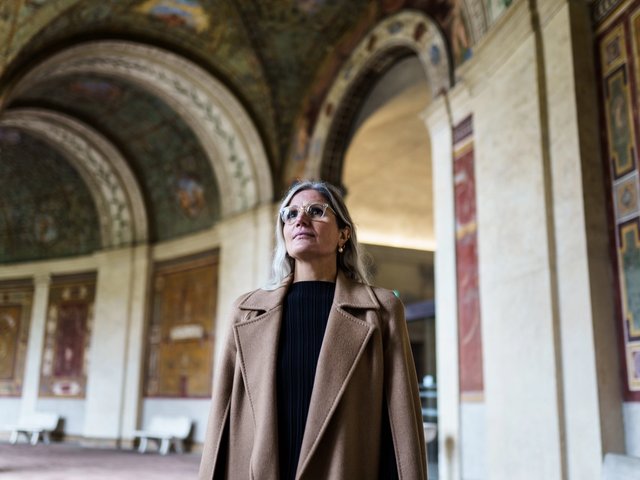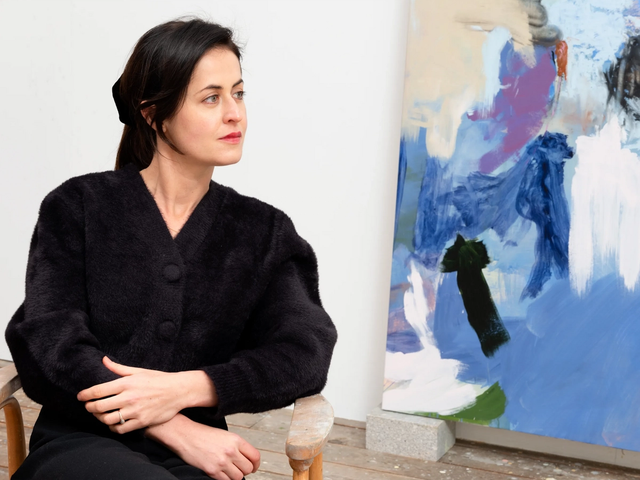The Art Newspaper: If you could live with just one work of art, what would it be?
Emma Talbot: It’s Old Woman with Labret, a 1973 mask by Freda Diesing, a Haida woman who started carving when she was 43. She made elderly figure masks and they have long grey hair. And they have this labret, which is a lip plate that makes the mouth stick out. So they have this very particular Indigenous form and the lines on the face are very stylised. They’re very beautiful.
Which cultural experience changed the way you see the world?
Being in Italy [for a residency, having won the Max Mara Art Prize for Women], has utterly changed how I see the world. If I could be based here, I would, because I love it. I think it’s because I learned Italian; for me, the experience of learning a language and being more a part of the life of a place—and then understanding the culture quite differently because I’m understanding phrases, ways of thinking—has been a total eye-opener. It sounds like a cliché to say you’ve fallen in love with Italy; so many people do. But, for me, it’s been a profound experience, which really has changed my life.
Which writers or poets do you return to?
It would be George Orwell, either Down and Out in Paris and London or The Road to Wigan Pier. Those are the books I’ve read the most. There are things I would always go back to, like Edna O’Brien’s Night and August is a Wicked Month; both of those I would reread. Anaïs Nin, not the erotic writing, but Collages, for example—I could reread those books endlessly. I really like Isabelle Stengers’s writing. So In Catastrophic Times: Resisting the Coming Barbarism is a really important book for me. I really want to mention Denis Johnson’s Train Dreams. In my studio, for a period of time, I used to listen to interviews with writers. Sometimes I hadn’t read any of their books, but I just liked listening to the way they talked. And the amount of times writers said, “Denis Johnson’s Train Dreams is such a great book”—I thought: “I have to read it.” And it’s a very slim book, but it is brilliant.
What music or other audio do you listen to while you’re working?
I have particular albums that I can play on repeat because they make a kind of atmosphere in the studio. One of them is Alice Coltrane’s Journey in Satchidananda, which I literally could play on repeat all day. Stevie Wonder’s Innervisions—just that album; I could make work to that all day. Vieux Farka Touré is a musician from Mali; there are a couple of albums of his that I could play non-stop. And the other one is Solid Air by John Martyn. And then Ute Lemper singing Kurt Weill is another thing that I could listen to a lot. But at the moment, I listen non-stop to Italian radio—Rai 3, a cultural radio programme, because now I find that I can actually follow it.
What is art for?
One good thing about art is that we don’t know what it is. So it could be anything. I think it is for sharing a kind of thinking that can’t be satisfied by another discipline; for opening out ideas that aren’t easily fixed down; for exploring, thinking and asking questions; for articulating intangible ideas, things that can’t be said. In terms of making art rather than looking at it, it has to be about the concerns of our age, it has to be about now.
• Listen to the full A brush with... podcast interview with Emma Talbot here
• Emma Talbot: The Age/L’Età, Max Mara Art Prize for Women, Whitechapel Gallery, London, until 4 September; Collezione Maramotti, Reggio Emilia, Italy, 23 October-19 February 2023. Her work is in The Milk of Dreams, 59th Venice Biennale, until 27 November.





